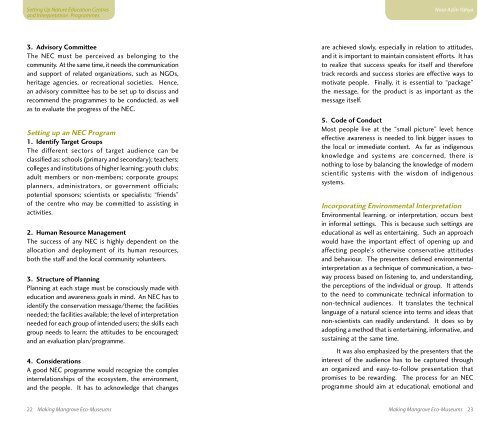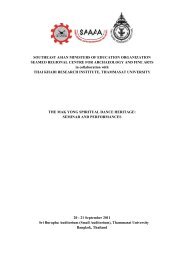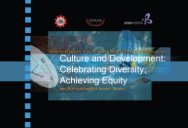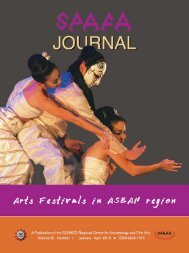Making Mangrove - Seameo-SPAFA
Making Mangrove - Seameo-SPAFA
Making Mangrove - Seameo-SPAFA
Create successful ePaper yourself
Turn your PDF publications into a flip-book with our unique Google optimized e-Paper software.
Setting Up Nature Education Centresand Interpretation ProgrammesNoor Azlin Yahya3. Advisory CommitteeThe NEC must be perceived as belonging to thecommunity. At the same time, it needs the communicationand support of related organizations, such as NGOs,heritage agencies, or recreational societies. Hence,an advisory committee has to be set up to discuss andrecommend the programmes to be conducted, as wellas to evaluate the progress of the NEC.Setting up an NEC Program1. Identify Target GroupsThe different sectors of target audience can beclassified as: schools (primary and secondary); teachers;colleges and institutions of higher learning; youth clubs;adult members or non-members; corporate groups;planners, administrators, or government officials;potential sponsors; scientists or specialists; “friends”of the centre who may be committed to assisting inactivities.2. Human Resource ManagementThe success of any NEC is highly dependent on theallocation and deployment of its human resources,both the staff and the local community volunteers.3. Structure of PlanningPlanning at each stage must be consciously made witheducation and awareness goals in mind. An NEC has toidentify the conservation message/theme; the facilitiesneeded; the facilities available; the level of interpretationneeded for each group of intended users; the skills eachgroup needs to learn; the attitudes to be encouraged;and an evaluation plan/programme.4. ConsiderationsA good NEC programme would recognize the complexinterrelationships of the ecosystem, the environment,and the people. It has to acknowledge that changesare achieved slowly, especially in relation to attitudes,and it is important to maintain consistent efforts. It hasto realize that success speaks for itself and thereforetrack records and success stories are effective ways tomotivate people. Finally, it is essential to “package”the message, for the product is as important as themessage itself.5. Code of ConductMost people live at the “small picture” level; henceeffective awareness is needed to link bigger issues tothe local or immediate context. As far as indigenousknowledge and systems are concerned, there isnothing to lose by balancing the knowledge of modernscientific systems with the wisdom of indigenoussystems.Incorporating Environmental InterpretationEnvironmental learning, or interpretation, occurs bestin informal settings. This is because such settings areeducational as well as entertaining. Such an approachwould have the important effect of opening up andaffecting people’s otherwise conservative attitudesand behaviour. The presenters defined environmentalinterpretation as a technique of communication, a twowayprocess based on listening to, and understanding,the perceptions of the individual or group. It attendsto the need to communicate technical information tonon-technical audiences. It translates the technicallanguage of a natural science into terms and ideas thatnon-scientists can readily understand. It does so byadopting a method that is entertaining, informative, andsustaining at the same time.It was also emphasized by the presenters that theinterest of the audience has to be captured throughan organized and easy-to-follow presentation thatpromises to be rewarding. The process for an NECprogramme should aim at educational, emotional and22 <strong>Making</strong> <strong>Mangrove</strong> Eco-Museums<strong>Making</strong> <strong>Mangrove</strong> Eco-Museums 23










